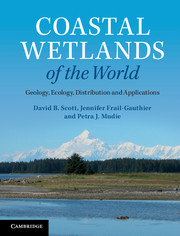Coastal Wetlands of the World Geology, Ecology, Distribution and Applications
Langue : Anglais
Auteurs : Scott David B., Frail-Gauthier Jennifer, Mudie Petra J.

A cutting-edge introduction to coastal wetlands and their applications, for students on related earth and life science courses and researchers.
Salt marshes and mangrove forests, the intertidal wetlands of the world's coastlines, provide key ecological services to all areas of the globe. This cutting-edge, richly illustrated book introduces the essential elements of coastal wetlands and their applications. The book opens by introducing coastal oceanography, the physical features of wetlands, their ecology, and human impacts upon them, giving all students the necessary background for wetlands studies. It then presents detailed case studies from around the world with extensive illustrations, supplying a wider, global-scale picture of wetlands geomorphology and biodiversity. The final chapters discuss some unique applications of coastal wetlands, including geological monitoring, uses in biotechnology and agriculture, and various experimental mesocosms. This is ideal as supplementary reading to support students on a wide range of earth and life science courses, from environmental science, ecology and palaeoecology to geomorphology and geography. It will also be a valuable interdisciplinary reference for researchers.
Preface; 1. Introduction; 2. Physical aspects: geological, oceanic and climatic conditions; 3. Zonations and plants: development, stressors and adaptations; 4. Animals in coastal wetlands: zonation, adaptations and energy flow; 5. Human intervention causing coastal problems; 6. Coastal wetlands worldwide: climatic zonation and ecosystems; 7. North American coastal wetland examples; 8. South American coastal wetland examples; 9. Africa: selected marsh and mangrove areas; 10. Europe and Asia: a view of what remains; 11. Australian and New Zealand wetlands; 12. Applications in geological monitoring: paleoseismology and paleoclimate; 13. Applications in conservation of biodiversity and agriculture; 14. Applications using mesocosms for study of coastal wetlands; 15. Conclusions and future directions; References; Index.
David Scott is Professor in the Earth Sciences Department of Dalhousie University where he teaches micropaleontology and quaternary geology. His other positions held include VP on the Cushman Foundation board, membership of the Geological Society of America and Paleontological Society, and serving as associate editor for the Canadian Journal of Earth Sciences. He has written over 130 refereed papers, has edited three NATO volumes on coastal geomorphology and paleontological subjects, and is also the co-author of Monitoring in Coastal Environments Using Foraminifera and Thecamoebian Indicators (with Franco Medioli and Charles Schafer, Cambridge University Press, 2001). Professor Scott has conducted field work in most major marshes of North America, and several wetlands in South America and Europe, in addition to participating in Ocean Drilling Program studies in the Indian Ocean.
Jennifer Frail-Gauthier is a PhD candidate in Earth Sciences and Biology at Dalhousie University, and her research topic is small food webs in salt marsh ecosystems, specifically foraminifera, which form an important part of this book. Her PhD focus is on experimental approaches to salt marshes for studies in ecology, biology, geology, restoration and other human impacts. Ms Frail-Gauthier is a Science Writing tutor and teaches third-year Applied Coastal Ecology, which focuses on the various coastal ecosystems of the world, including geology, ecology, and anthropogenic impacts, and also teaches various biology courses. She has received several major scholarships and awards during her graduate studies, and also holds a Teaching Excellence award and a University Medal from Dalhousie University.
Petra Mudie is an Adjunct of the Graduate Studies Faculty at Dalhousie University, Adjunct Professor of Memorial University of Newfoundland, and a Scientist Emeritus with Geological Survey of Canada Atlantic. Her previous work includes heading up a Halophyte Research laboratory at the Scripps Ins
Jennifer Frail-Gauthier is a PhD candidate in Earth Sciences and Biology at Dalhousie University, and her research topic is small food webs in salt marsh ecosystems, specifically foraminifera, which form an important part of this book. Her PhD focus is on experimental approaches to salt marshes for studies in ecology, biology, geology, restoration and other human impacts. Ms Frail-Gauthier is a Science Writing tutor and teaches third-year Applied Coastal Ecology, which focuses on the various coastal ecosystems of the world, including geology, ecology, and anthropogenic impacts, and also teaches various biology courses. She has received several major scholarships and awards during her graduate studies, and also holds a Teaching Excellence award and a University Medal from Dalhousie University.
Petra Mudie is an Adjunct of the Graduate Studies Faculty at Dalhousie University, Adjunct Professor of Memorial University of Newfoundland, and a Scientist Emeritus with Geological Survey of Canada Atlantic. Her previous work includes heading up a Halophyte Research laboratory at the Scripps Ins
Date de parution : 03-2014
Ouvrage de 364 p.
19x24.6 cm
© 2024 LAVOISIER S.A.S.



